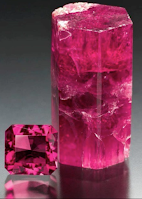Although an accurate and characteristically fitting name to describe red beryl, there's a bit of controversy in calling it a red emerald. Emeralds are so associated with the color green that some geological associations are afraid consumers will feel deceived by the term red emerald. Personally, I disagree. The adjective "red" lets you know the beryl is not green.
Red beryl was discovered in 1904 in the Wah, Wah mountains of Utah by Maynard Bixby, an American mineralogist. The gemstone is very rare and thus far has only been found in Utah and New Mexico.
Just like it sibling beryl, green emerald, red beryl is a class 3 gemstone, meaning it's very brittle and highly included. Also like green emeralds, oil treatments are acceptable to improve the appearance of a red emerald's inclusions. Oil treatments don't change or damage the gemstone.
All beryls are distinguished by hexagonal crystal systems. In nature, pure beryl is colorless but acquires its color from trace amounts (that is to say, impurities) of additional elements. While chromium and vanadium give emerald its green color, and iron makes aquamarine blue, when manganese produces a deep red color, it's called red beryl or red emerald. Of course, beryls also come in pink, and yellow, but for now, let's discuss red.
Registering 7.5 - 8 on Moh' Hardness Scale, red emeralds come in red-red, purplish-red, or orangy-red. Big stones are especially rare finds. According to the Gemmological Association of Great Britain, a 2-carat red beryl is as rare as a 40-carat diamond. The gem association says, "only one red beryl is mined for every 150,000 diamonds.'' And consider this, the scarlet gem is scarcer on earth than gold.
What I think is super cool ... May babies have another color of birthstone!
Due to the gemstone's rarity and the lack of abundant production, good quality red emeralds can fetch up to $10,000 per carat. Still be aware that like its sibling green emeralds, or diamonds, sapphires, and rubies, there are various degrees of gem-quality stones. Not all red beryl is equal, and clarity, color, and size apply to determine its value. According to gemstone wholesaler Equatorial Imports, red beryl tends to price twice the value of emerald.🟩
Would you like to own a red emerald?
You may also enjoy:
















